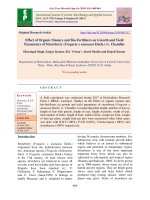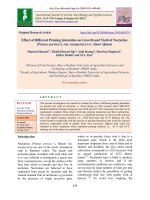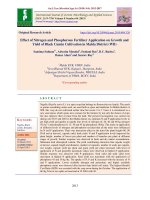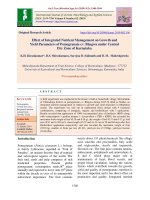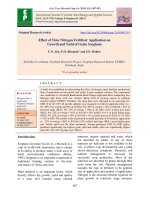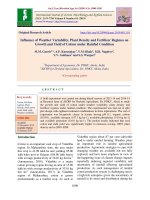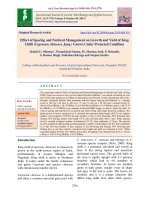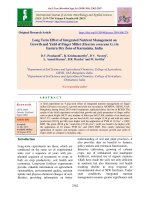Effect of time nitrogen fertilizer application on growth and yield of grain sorghum
Bạn đang xem bản rút gọn của tài liệu. Xem và tải ngay bản đầy đủ của tài liệu tại đây (158.64 KB, 6 trang )
Int.J.Curr.Microbiol.App.Sci (2019) 8(5): 987-992
International Journal of Current Microbiology and Applied Sciences
ISSN: 2319-7706 Volume 8 Number 05 (2019)
Journal homepage:
Original Research Article
/>
Effect of Time Nitrogen Fertilizer Application on
Growth and Yield of Grain Sorghum
U.N. Alse, P.O. Bhutada* and S.P. Mehtre
All India Co-ordinate Sorghum Research Project, Sorghum Research Station VNMKV,
Parbhani, India
*Corresponding author
ABSTRACT
Keywords
Nitrogen time of
application,
Sorghum, Nitrogen
method of
application
Article Info
Accepted:
10 April 2019
Available Online:
10 May 2019
A study was established for determining the effect of nitrogen (urea) fertilizer method and
time of application on the growth and yield of grain sorghum varieties. The experiment
was conducted as a Factorial Randomized Block Design replicated thrice comprising five
Nitrogen split doses with two varieties during 2014-15 growing season at sorghum
research station VNMKV, Parbhani. The main plots were allocated to two genotype G1:
CSH 16 & G2: CSV 20 and the subplots were assigned to fertilizer application time viz.,
N1: 50% N at sowing and 50% at 30 DAS, N2: 50% at sowing + 25% at 30 DAS + 25% at
boot-leaf stage (BLS), N3: 25% at sowing + 50% at 30 DAS +25% at Boot leaf stage
(BLS), N4: 25% at sowing + 50% at 30 DAS +15% at BLS +10 % at grain filling stage
(GFS), N5: 25% at sowing + 45% at 30 DAS + 5% at foliar spray at 45 DAS +15 % BLS
+ 10% at GFS. The results of the experiment revealed that time of N fertilizer application
i.e. 25% at sowing + 50% at 30 DAS +25% at Boot leaf stage (BLS ) gives higher grain
and fodder yield over the other treatments. Among genotypes CSH 16 (2982 kg/ha)
produced significantly the highest grain yield and fodder yield was significantly higher
with CSV 20 (11373 kg /ha) over CSH-16.
nutrients, organic material and water, which
are absorbed by plants. If any of these
nutrients are deficient or not available in the
soil, it affects crop development and a plant
shows deficiency symptoms. Therefore, soil
nutrient management is necessary for
successful crop production. Most of the
nutrients are absorbed by plants through their
roots from the soil. Nutrient management
includes the type of fertilizer to be applied,
rate of application and method of application.
Nitrogen is the essential element required for
plant growth in relatively large amounts.
Introduction
Sorghum (Sorghum bicolor (L.) Moench) is a
crop of world-wide importance and is unique
in its ability to produce under a wide array of
harsh environmental conditions (House,
1995). Sorghum is an important component in
traditional farming systems in the semiarid tropics of Africa and Asia.
Plant nutrition is an important factor, which
directly affects the growth, yield and quality
of a crop. Soil contains many mineral
987
Int.J.Curr.Microbiol.App.Sci (2019) 8(5): 987-992
However, deficiencies of nitrogen are
common. Nitrogen deficiency can result in
reduced dry matter, crude protein and grain
yield (Jarvis, 1996; Ashiono et al., 2005). Soil
nutrients become depleted due to leaching of
nitrogen, soil erosion and removal by crops
(Zobeck et al., 2000). In soils with good
aeration nitrate (NO3–) is the dominant form
of available nitrogen in higher plants. Its
absorption and pattern of distribution in
different parts of a plant is very important.
Nitrate that is not absorbed by plants may
contaminate underground or surface water by
nitrate leaching or soil erosion. Increasing
Nitrogen Use Efficiency (NUE) in plants is
considered as a major way to decrease nitrate
accumulation and its leaching in the soil. N
source and method of fertilizer application
have been identified as factors influencing
NUE, as well as the pathway of N loss from
the soil-plant system (Raun and Johnson,
1998).
rather than applying at sowing, increased dry
matter and grain yield of sorghum (Joseph et
al., 1997). Grain yield of corn was 10.5 and
11.2 Mg ha-1 for nitrogen fertilization at
planting and six-leaf stage, respectively
(Sainz Rozas et al., 2004).
Materials and Methods
An experiment was conducted during kharif
2014-15 at S.R.S. VNMKV Parbhani, in
Factorial
Randomized
Block
Design
replicated thrice comprising five Nitrogen
split doses with two varieties. The main plots
were allocated to two genotype G1: CSH 16 &
G2: CSV 20 and the subplots were assigned to
fertilizer application time viz., N1: 50% N at
sowing and 50% at 30 DAS, N2: 50% at
sowing + 25% at 30 DAS + 25% at boot-leaf
stage (BLS), N3: 25% at sowing + 50% at 30
DAS +25% at Boot leaf stage (BLS), N4: 25%
at sowing + 50% at 30 DAS +15% at BLS
+10 % at grain filling stage (GFS), N5: 25% at
sowing + 45% at 30 DAS + 5% at foliar spray
at 45 DAS +15 % BLS + 10% at GFS. The
gross and net plot size were 4.5 m X 5.0 m
and 3.6 X 4.4 m respectively. The sorghum
genotype CSH-16 and CSV-20 were sown on
10th July, 2014 and harvested on 3rd Nov.
2014.
There is difference for NUE, among different
sorghum hybrids. Genetic variation was
observed for N utilization between early and
late-maturity sorghum hybrids. Genotypic
variation has been observed for utilization of
absorbed N for biomass production and
harvest index (Gardner et al., 1994). The best
time of nitrogen fertilizer application will
significantly improve both quantity and
quality of crops as well as NUE (Almodares,
1996).
The recommended plant protection schedule
was followed. The crops were fertilized as per
the treatments. Sorghum was sown with row
spacing of 45 cm and seeds 12 cm apart on
each row having seed rate 7.5 to 10 kg
respectively as per genotype. Important
physical and chemical characteristics of soil
samples were determined in laboratory
including soil texture clay in nature, low in
organic carbon (0.58), pH-8.5, low in
available nitrogen (166.80 kg/ha) and medium
in phosphorus (19.80 kg/ha) and high in
potassium (358.50 kg/ha). Treatment details
as below
In a study for determination of suitable time
of nitrogen fertilizer application for grain
sorghum, it was concluded that, if plants are
sown in proper time, three-phase distribution
of nitrogen fertilizer has the best effect on
total dry weight, protein and height of plants
(Kohanmoo
and
Mazahery,
1995).
Application of nitrogen fertilizer at eight-leaf
growth stage is feasible and would be
beneficial for sorghum (Khosla et al., 2000).
Delaying N fertilization 40 days after sowing,
988
Int.J.Curr.Microbiol.App.Sci (2019) 8(5): 987-992
Treatment details
Results and Discussion
Main plot: G1: CSH 16 & G2: CSV 20
Nitrogen Fertilizer time of application had a
significant effect on growth and Grain and
fodder yield (Table 1).
Sub-plot: N application methods
N1: 50% N at sowing and 50% at 30 DAS
N2: 50% at sowing + 25% at 30 DAS + 25%
at boot-leaf stage (BLS)
N3: 25% at sowing + 50% at 30 DAS +25% at
Boot leaf stage (BLS)
N4: 25% at sowing + 50% at 30 DAS +15% at
BLS +10 % at grain filling stage (GFS)
N5: 25% at sowing + 45% at 30 DAS + 5% at
foliar spray at 45 DAS +15 % BLS + 10% at
GFS
Grain yield
The splitting of N in three doses i.e. 25% at
sowing + 50% at 30 DAS +25% at Boot leaf
stage (BLS) (3015 kg/ha) produced
significantly higher grain yield than rest of
treatments, however it was at par with N5 and
N4. This indicated that three splitting of
nitrogen found significantly superior over two
splitting.
Table.1 Grain and fodder yield, gross monetary returns, net monetary returns and benefit: cost
ratio as influenced by various treatment
Treatments detail
N splitting
N1: 50% N at sowing and 50% at 30 DAS
N2: 50% at sowing + 25% at 30 DAS +
25% at boot-leaf stage (BLS)
N3: 25% at sowing + 50% at 30 DAS
+25% at Boot leaf stage (BLS)
N4: 25% at sowing + 50% at 30 DAS
+15% at BLS +10 % at grain filling stage
(GFS)
N5: 25% at sowing + 45% at 30 DAS +
5% at foliar spray at 45 DAS +15 % BLS
+ 10% at GFS
SE+CD at 5%
Genotypes
V1:CSH 16
V2:CSV 20
SE+CD at 5%
Interaction
SE+CD at 5%
Grand mean
Grain yield Fodder
(kg/ha)
(kg/ha)
yield GMR
(Rs/ha)
NMR
(Rs/ha)
B:C
ratio
2053
2683
7869
9898
4731
52379
11435
22966
1.29
1.53
3015
12068
61008
31808
1.71
2834
11017
56505
26507
1.59
2791
10482
54883
24135
1.54
79
236
336
1008
1963
5889
1357
4071
0.03
0.09
2982
2368
50
149
9160
11373
213
639
58947
47255
1241
3723
29516
17224
858
2575
1.66
1.41
0.02
0.06
112
NS
2675
476
NS
10267
2775
NS
53101
1919
NS
23370
0.04
NS
1.53
989
Int.J.Curr.Microbiol.App.Sci (2019) 8(5): 987-992
Table.2 No. of panicles, 50% flowering, physiological maturity, plant height and 100 seed
weight as influenced by various treatments
Treatments detail
N splitting
N1: 50% N at sowing and 50% at 30
DAS
N2: 50% at sowing + 25% at 30 DAS +
25% at boot-leaf stage (BLS)
N3: 25% at sowing + 50% at 30 DAS
+25% at Boot leaf stage (BLS)
N4: 25% at sowing + 50% at 30 DAS
+15% at BLS +10 % at grain filling
stage (GFS)
N5: 25% at sowing + 45% at 30 DAS +
5% at foliar spray at 45 DAS +15 %
BLS + 10% at GFS
SE+CD at 5%
Genotypes
G1:CSH 16
G2:CSV 20
SE+CD at 5%
Interaction
SE+CD at 5%
Grand mean
No. of
50%
panicles/m2 flowering
(Days)
Physiological
maturity
(days)
Plant
(cm)
height 100 seed wt (g)
14
64
116
222
2.85
14
64
116
226
3.00
14
66
118
233
3.27
14
66
118
232
3.17
13
65
117
228
3.10
0.13
NS
0.40
1.20
0.40
1.20
1.22
3.64
0.25
NS
14
14
0.04
NS
64
66
0.25
0.76
116
118
0.25
0.76
184
272
0.77
2.30
0.11
0.34
0.19
NS
14
0.57
NS
65
0.57
NS
117
1.73
NS
228
0.25
NS
3.08
Fodder yield
Fodder yield
The fodder yield was highest under treatment
N3 (12068 kg/ha) than other nitrogen splitting.
This might due to availability of nitrogen up
to boot leaf stage.
Fodder yield was significantly higher with
CSV 20 (11373 kg/ha) as compared to CSH
16 (9160 kg/ha), because variety produces
higher fodder yield than hybrid.
Genotypes
Economics
The application of three split doses of N i.e.
25% at sowing + 50% at 30 DAS + 25% at
boot leaf stage returned significantly higher
gross returns (Rs. 61008/ha) except net
(Rs.3108/ha) and B:C (1.71) ratio as
compared to other treatments, it was
significantly comparable with treatment T4.
Grain yield
Hybrid CSH 16 (2982 kg/ha) produced
significantly the highest grain yield than CSV
20 (2368 kg/ha). This might be due to genetic
characteristic of genotypes.
990
3.32
2.83
Int.J.Curr.Microbiol.App.Sci (2019) 8(5): 987-992
The genotype CSH 16 expressed significantly
greater amount of gross (58947/ha), net
(29516/ha) and B:C ratio (1.66) as compared
to CSV 20, sowing to higher grain yield.
fertilization on N2 fixation, N recovery
and soil profile nitrate dynamics on
sorghum/pigeon pea intercrops on
Alfisols on the semi-arid tropics.
Nutrient cycl. Agroecosys., 48: 197208.
Kasmshita, A., S. Fukai, R.C. Muchow and
M. Cooper, 1998. Sorghum hybrid
differences in grain yield and nitrogen
concentration under low soil nitrogen
availability.
II.
Hybrids
with
contrasting phenology. Aust. J. Agric.
Res., 49: 1277-1286.
Khosla, R., M.M., Alley and P.H. Davis,
2000. Nitrogen management in notillage grain sorghum production: I.
Rate and time of application. Agron.
J., 92: 321-328.
Kohanmoo, M., and D. Mazahery,
1998. Effect of nitrogen fertilizer
distribution and irrigation period
(time) on yield and protein of forage
sorghum. Proceedings of the 5th
Iranian Congress of Crop Production
and Plant Breeding, August 31September 1, 1998, Karaj, Iran, pp:
311-.
Raun,
W.R.,
and
G.V.
Johnson,
1999. Improving
nitrogen
use
efficiency for cereal production.
Agron. J., 91: 357-363.
Raun, W.R., G.V. Johnson, S.B. Phillips, and
R.L. Westerman. 1998. and nitrogen
use efficiency of six spring wheat
(Triticum aestivum Effect of long-term
N fertilization on soil organic C and
total N L.) cultivars, in relation to
estimated moisture supply. Can. J.
Plant in continuous wheat under
conventional tillage in Oklahoma. Soil
Sci. 72:235–241. Tillage Res. 47:323–
330
Sainz Rozas, H.R., H.E. Echeverria and P.A.
Barbieri, 2004. Nitrogen balanced as
affected by application time and
nitrogen fertilizer rate in irrigated no-
Interaction
Interaction effect found to be non significant.
Ancillary data
Three Split application of nitrogen i.e N3
recorded higher plant height and 100 seed
weight over rest of treatment (Table 2)
In conclusion, nitrogen should be applied in
three (N3) split doses to kharif sorghum to
produce higher grain and fodder yield. Hybrid
CSH 16 produces more grain than fodder
yield recorded by CSV-20.
References
Almodares, A., 1996. Effect of genotype and
nitrogen content on protein of grain
sorghum. J. Res. Construct., 32: 6065.
Ashiono, G.B., S. Gatuiku, P. Mwangi and
T.E. Akuja, 2005. Effect of nitrogen
and phosphorus application on growth
and yield of dual-purpose sorghum
(Sorghum
bicolor (L.)
Moench),
E1291, in the dry highlands of Kenya.
Asian J. Plant Sci., 4: 379-382.
Gardner, J.C., J.W. Maranville and E.T.
Paparozzi,
1994. Nitrogen
use
efficiency among diverse sorghum
cultivars. Crop Sci., 34: 728-733.
House, L.R., 1995. Sorghum: One of the
world's great cereals. Afr. Crop Sci. J.,
3: 135-142. Jarvis, S.C., 1996. Future
trends in nitrogen research. Plant Soil,
181: 47-56.
Joseph, J., Adu-Gyam Fi, O. Ito, T.
Yoneyama, D. Gayatri and K.
Katayama, 1997. Timing of N
991
Int.J.Curr.Microbiol.App.Sci (2019) 8(5): 987-992
tillage maize. Agron. J., 96: 16221631.
Zobeck, T.M., N.C. Parker, S. Haskell and K.
Guoding, 2000. Scaling up from field
to region for wind erosion prediction
using a field-scale wind erosion model
and GIS. Agric. Ecosyst. Environ., 82:
247-259.
How to cite this article:
Alse, U.N., P.O. Bhutada and Mehtre, S.P. 2019. Effect of Time Nitrogen Fertilizer
Application on Growth and Yield of Grain Sorghum. Int.J.Curr.Microbiol.App.Sci. 8(05): 987992. doi: />
992
